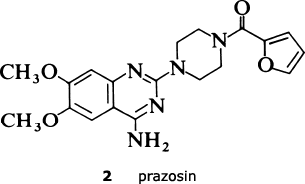5.2 The pharmaceutical background
The existence of alpha receptors had been known for many years, and the obvious approach of trying to block these receptors, and hence prevent the noradrenaline from binding, had already been tried by many research groups. A number of compounds with alpha-blocking activity had been identified, including one called prazosin (2) discovered by Pfizer at their US research laboratories in Groton. Substances such as prazosin which block agonist action are called antagonists.

However, none of the early alpha-blockers, with the single exception of prazosin, reduced blood pressure other than transiently; furthermore, the old alpha-blockers usually displayed undesirable side-effects. Prazosin, on the other hand, was shown to be effective at lowering blood pressure and safe in toxicological evaluation, and so in due course was made available for the treatment of hypertension.
Prazosin needed to be taken two or three times a day, whereas, as indicated earlier, a once-daily therapy would be preferable for the treatment of a chronic condition such as hypertension; furthermore, the lack of detailed understanding of the mechanism of action of prazosin (in other words, the answer to the question: why was it effective where other alpha-blockers were not?) was a significant limitation to implementing a rational follow-up programme and, after some initial work, research in this area was discontinued.
